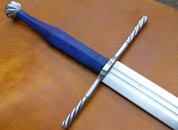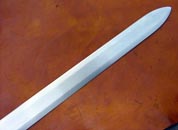
 |
 |
The Maximilian is inspired by the many examples of smaller zweihander (zweihander = two-hander) swords carried by the Landesknecht, or German mercenaries of the 15th and 16th centuries. The term Landsknechte was first coined by Peter von Hagenbach, recorder for Charles the Bold of Burgundy, meaning "servant of the country (land)," and first began appearing in common use in approximately 1470. The appellation was given primarily to the mercenary soldiers from the areas of Alsace, Baden Wurttemburg, and Austrian Tyrol who were trained to fight with pikes, zweihanders and later with the early firearm, the arquebus. Maximilian I was the German king (1486-1519) and Holy Roman emperor (1493-1519), who established the Hapsburg dynasty as an international European power. In 1477 he married Mary, daughter of Charles the Bold, duke of Burgundy, but his right to the Burgundian realm was challenged by the French king, Louis XI. Maximilian successfully defended his wife's inheritance in a war with France that lasted until 1493. Maximilian I is also credited with the creation of the Landsknechts, which he formed in order to uphold his claim to the Burgundian legacy of the Netherlands and to control his future territories in the east. The first Landsknechts were recruited in 1487, to protect the Swabian alliance (1487-8) and keep the powerful princes of Bohemia and Bavaria at bay. Maximilian owed much of his success of his Landsknechts to the Lord of Mindelheim, Georg von Frundsberg, who is regarded by many as the true "father of the Landsknechts." This new military force was closely modeled on the fierce and well trained halbardiers and pikeman of the Swiss Confederation: the Swiss Mercenaries. The face of war was changing dramatically during this period. The Burgundian Wars (1476-7) had shown that heavy cavalry was virtually useless against well trained pike formations, and the cost of training and equiping mounted troops was becoming too much of a burden on the European nobility. This new mobile infantry of pikemen were more easily trained in large numbers and quickly became the main body of mercenary armies throughout Europe. The Landsknecht army would have been a fearsome sight to behold -- thousands of men wearing what would appear to be brightly colored rags and hats with many gaudy, brightly colored feathers. Their clothes, taken from their fallen opponents and not always fitting properly, was slashed and tied together to fit the new owner -- a look that would later become the trendy fashion among the nobility. The very last time Landsknecht were utilized was on the 14th of March, 1590, at Ivry. 6,000 Landsknecht and other Catholic League soldiers faced 10,000 troops belonging to Henry IV of France. The battle was decided by the cavalry before the infantry even could come to blows. The Landsknecht, left in the center of the field, surrendered and were slaughtered.
The Maximilian Landesknecht Sword The Maximilian's blade design post-dates Oakeshott's typology range, which stops at the tapering multiple-fullered blades of Type XXII. Similar to the long examples of Type XX, XXI and XXII blades, the Maximilian blade is long, double-edged and has two fullers, but has a very gradual profile taper and the fullers extend further down the blade. The sword was designed for broad, sweeping cutting blows (such as clearing a line of pikes) and then for thrusting by using a "half-swording" technique (gripping the hilt in one hand and the blade in the other) in close-quarter fighting. Landesknecht and Swiss Mercenaries are often depicted in period woodcuts as carrying a shorter sword (often a katzbalger) as a sidearm in addition to the zweihander, presumably for use in close-quarter combat. Name That Sword Contest Winner Daniel Lacoretz "I propose the name of this sword "The Maximilian" Please read this excerpt: "In the late 15th century, Maximilliam of Austria (later Holy Roman Emperor Maximillian I) needed a highly trained, well disciplined army in order to consolidate his hold on his wife's inheritance of the Netherlands against Louis XI of France. He based his troops and their training on the Swiss model of pikemen. This heralded the return of the infantry as an effective fighting force, and sounded the death knell for the era of the mounted knight. In companies of five hundred, armed with 15-18 foot pikes, the Lanksknechts (german for "land servants") quickly became the most highly respected and feared troops in Europe." This fragment is from http://www.st-mike.org/groups/german/ (no plagiarism here :) While similar in style to the #3 [Tyrolean] sword, this is more ornate, thus more fitting for a King than a soldier. A great homage to the creator of the "Landsknechte" and a great name for a sword." A Limited Edition Hand Crafted Collectible Sword This sword is offered in a limited edition of only 500 collectible swords worldwide. Specifications Overall length: 55” (139.7 cm) Blade length: 41” (104 cm) Blade width: 2.1875” (5.56 cm) COG: 4.5” from guard (11.43 cm) COP: 22” from guard (end of fullers) (55.88 cm) Weight: 5 lbs 1 oz (2.3 kilos) Grip length: 11.5” (29.21 cm) Guard Width: 11.5” (29.21 cm) You can customize your sword's grip color -- see the standard grip colors here The Maximilian... $1,650 The Maximilian with half-wire grip... $1,870 Reserve now before this limited edition collectible sword runs out! |
 |
 |
 |
 |
| Sword design/specifications
©2003/2007 Peter Johnsson. Albion Armorers International is the sole worldwide licensee for this product |
|
|
Albion
offers a maintenance plan to keep your Albion Mark swords like new.
Click here for details
|
